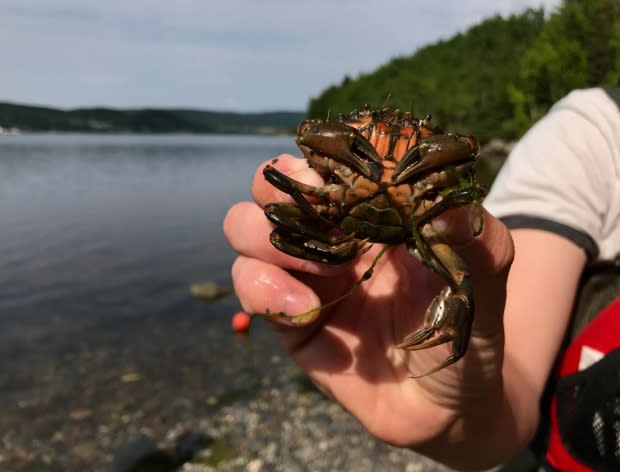Bay of Islands group keeping tabs on green crabs with expanded trapping effort
It's almost too humid a day to be wearing hip waders, and two summer students with ACAP Humber Arm find relief by wading off the shore by the Summerside marina.
What's in the traps they haul up, however, is pretty unpleasant.
Green crabs skitter about inside — diminutive but aggressive creatures, considered to be one of the world's most invasive species.
They're all too familiar to ACAP Humber Arm staff, who were the first to document green crabs in the Bay of Islands in 2012. Those sightings came five years after green crabs, originally from Europe, were first spotted in Newfoundland waters in Placentia Bay in 2007.
Staff trapped the crabs regularly through 2015, after which the program trailed off, partly as a victim of its own success: crab numbers had dropped off drastically. But now the organization has decided it's time to check back in with a species notorious for its adaptability, and make a three-year sustained effort to trap and track them.
"It's going to be interesting to see now, after those years have gone by, whether those populations of theirs have rebounded or stayed suppressed," said Greg Moore, the research manager at ACAP Humber Arm.

In the first two weeks of the project, Moore and his colleagues have captured 100 crabs.
"It's about what we're expecting so far," he said.
"We're going to see those numbers increase, I think, as summer progresses."
Cockroaches of the sea
Green crabs are often unflatteringly compared to cockroaches, thanks to their hard-to-kill qualities, the list of which is fairly impressive.
"They can survive out of water for weeks on end. They can survive in fresh water," said Moore.
The crabs can survive extreme temperature fluctuations, and Moore noted that the green crabs ACAP Humber Arm staff trap will need to stay zip-locked in a freezer for a week to ensure their demise.
And green crabs might just outstrip unlovable cockroaches in the amount of damage they can wreak on an ecosystem.
They'll eat anything, and also claw up eelgrass, a habitat that plays home to an important array of underwater life, such as juvenile cod, hake and herring.
"We have seen declines in eelgrass throughout the region," said Moore.

Unknown numbers
Along with eelgrass, Moore said other species in the Bay of Islands, such as rock crab and lobster, have also lost out since green crabs took up residence.
"What we're looking to do is actually try and suppress the population, to help benefit both the local populations of native crab species and lobster species within the bay. Because these green crab, they tend to create a lot of pressure on these species by outcompeting them," he said.
Trapping has proved effective in the past.
When ACAP Humber Arm first began capturing green crabs, said Moore, they did so in large numbers: one two-day trapping spree at a Bay of Islands site netted 2,000.
Another site went from 1,000 crabs caught in the first year to about 50 or 60 a few years later.
At the start of this new trapping push, ACAP Humber Arm is wading into a lot of unknowns.
"Now, we're not sure whether those numbers have rebounded," said Moore.

A female green crab can lay 185,000 eggs at a time, and there's no current estimate on the population in the Bay of Islands.
ACAP Humber Arm aims to be able to put a number on that by the end of its three-year study, which for the next two years will run from when spring breaks up the sea ice until about October.
"Hopefully, the population levels are still low enough that this trapping effort will continue to suppress the population within the Humber Arm," said Moore.
"Time will tell."
Read more from CBC Newfoundland and Labrador


